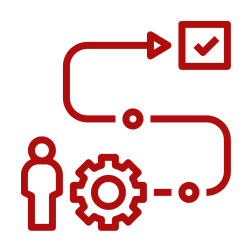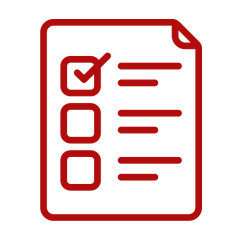
Project management can only be implemented when we touch on the barriers, difficulties and challenges specific to the one and only organization and team. Although the principles of management do not change, the key is to ADAPT them to the identity of the organization. This identity consists of the current organizational arrangements, the people working in the organization, the tools it uses and the way it is managed.
It is possible to prescribe medication without a diagnosis, but in such case we have to rely on chance. For this reason, we propose to start by diagnosing the situation, gathering the facts and using them as a basis for recommending further actions. During the diagnostic process you get a report on the organization in the context of project management and an action plan to be followed in order to achieve the expected results. During the diagnosis, we look for strengths and we seek to understand the key to success in your projects. And where you want your company to be in the future. Because we design a process that will be ready for change.
The Project Management Audit is a proven and practical way to comprehensively improve and implement a project management process focused on your Organization.

Comprehensive diagnosis

Practical recommendations

Specific implementation plan

Visible change

Don’t waste time, nerves and money, get a tailored, flexible and efficient way of working with projects at your company.
 Are you a business owner?
Are you a business owner?
Is your business growing faster and you can no longer control it? You have more and more projects, more and more work, but things are not happening as fast as they used to? Something that used to be well arranged suddenly stops working? Do you feel that you are reaching a glass ceiling? Communication chaos appears and projects are delayed further and further? Individual teams only focus on their specific jobs and are not open to collaborating with others? There are so many things arriving at your office that it is difficult to find time for decisions and for the people implementing projects? Your company has grown very quickly and you want to structure it well, but you do not want to be like a corporate organization? Your people are overburdened and there is still more work ahead of you? You are doing projects on the fly and the company is growing yet you are no longer in control of the throughput and finance? You want to keep the company running in a structured way because you have a big thing coming up? You are working with a client and the project gets disintegrated? You want the best and as a result you are going over the budget?
 Your people are running the projects?
Your people are running the projects?
They find it difficult to make others work and the projects are delayed? There is chaos and communication problems? Decisions are not being made on time? You can see that the teams fail to exchange information properly, something is not working and people are not delivering? Jobs are stretched out over time and your managers have no control over individual project tasks or the available resources? Unnecessary procedures slow down the project work, increasing costs and adversely affecting the morale of the team? Interpersonal tensions and lack of effective conflict resolution affect the work atmosphere and productivity? Processes are not structured and everything seems to be happening in a vacuum? Your managers fail to make others do their jobs? Projects are not delivered on schedule, deadlines are missed and budgets are exceeded? Communication standards are lacking, resulting in misunderstandings and errors? Inefficient decision-making processes are causing stagnation in projects? Key information fails to reach the right people at the right time, which affects productivity? Employees do not have access to the right tools, which makes project management difficult? Individual teams are working without clear objectives or direction, which affects their motivation and performance? Changes are made to projects without proper planning and communication, causing confusion and resistance? You experience a lack of support and commitment to projects from senior management? Projects are not integrated into the company’s strategy, resulting in low returns on investment?
 A good match for small, medium, large companies
A good match for small, medium, large companies
Small, medium-sized and large companies have different characteristics, just like every specific industry. This is an important factor that we take into account for the audit. Because we have worked with companies from a wide spectrum of industries and sizes, at different levels of project and process maturity, we can choose the right solutions that you can put into practice, instead of theoretical models that only work for one specific type of organization.
 Working with an experienced auditor
Working with an experienced auditor
The audit is carried out by experienced top experts in their respective areas of specialization. Among them, there are project management experts, business consultants as well as experienced trainers/coaches in management, leadership and team cooperation. This is important because you will not only learn “how to do it by the book”, but you will also get specific solutions from the consulting team, based on their experience with projects.
 Focusing on what is at the heart of the business
Focusing on what is at the heart of the business
Focusing on what works and what matters most for your business. We search for whatever works best for the growth of your business in a simple and quick way. It is not project management as such, nor a team of trainers, which is at the center of attention. It is your company’s core business and the way this business is done. The solutions we choose take into account the unique characteristics of your business, your industry and the practices you have developed to maintain what has made you successful.
 Focus on 3-5 points of support
Focus on 3-5 points of support
When the main focus is on the essential aspects for the company’s development, the effects of change will be more successful for the organization and will give it leverage in its growth. You get a plan that you will implement quickly, see the results and decide what to do next, avoiding a situation where the only thing to do is “improve on everything”.
 The KISS PM® 12 Questions model
The KISS PM® 12 Questions model
The entire audit system is based on the KISS PM® 12 Questions method, with questions asked in a simple and direct language. As a result, there is no need to provide project management training to everyone in the company to enable them to work. Moreover, it is the only method with the assumption of starting with the simplest possible solution and expand it with more complex methods afterwards. There are many methods telling you that you need to know the big picture in order to cut out unnecessary pieces from a complex structure to fit specific projects. With the 12 Questions, there is no risk of people saying “this is too complicated and may be cool, but not for us.” You need the Leadership Center to learn the KISS PM® 12 Questions method.
 Project Lever Mechanism™
Project Lever Mechanism™
It is an effective model of project work, a simple, practical and efficient system for successfully starting and completing projects. Throughout the years of working with clients, we have developed a model of project work at the following essential levels: sponsor, manager, project manager and project participants. Project and business management is a system, which you need to approach with a certain understanding of how the specific pieces of the puzzle interact with each other.
 A model based on statistical research
A model based on statistical research
The model is not only based on our experience of working with clients and global standards (Project Leverage™ and the KISS PM® 12 Questions method are compatible with PMBOK®, Prince 2, IPMA or Scrum approach, or more broadly with Agile or Lean), but on statistical data, verifying when hierarchy-based management should be recommended, when to give full freedom and whether the project approach and performance are correlated. You get empirically and scientifically proven knowledge.
 You are in full control
You are in full control
At every stage, you are able to verify if our work meets your expectations and if our discoveries are sufficient for taking the next step. You work with a partner who offers extensive knowledge and experience in project management and who listens to you. We show you the results of our work and you assess whether we have understood the problems properly, whether the solutions are consistent your vision, whether the workshops meet your expectations. We do not immediately plan for months; rather, we work systematically together on what is needed at the given time. Because you will be able to see value in these quick wins and steer the change in the desired direction.
 A ready-made recipe for implementation
A ready-made recipe for implementation
You get a set of implementation instructions and a workshop to start putting the post-audit recommendations into practice right away. You will not get a list of things to change, just 2 or 3 points of support, a complete workshop plan to turn the recommendations into practical action in your team. You do not have to read a document, you just start acting and the team initiates change in the desired direction.
The first aspect of evaluation is the project management process. What parts of it are already functioning in the organization in a more or less formalized way. What parts are missing. The focus is on how projects are started, run and completed at the company. How teams are involved across the different functions. How all projects in the organization are controlled and managed. To what extent the process reinforces the lessons learned.
The second aspect of the diagnosis covers cooperation, communication and identity of the organization. How well the teams are prepared to work across the various functions. How people communicate. Where the barriers are for decision-making or information sharing. How teams deal with conflicts and difficulties. What levels of project management awareness and competence, conscious or unconscious, already exist at the company.
The third aspect of the audit is an overview of the tools used in the organization, beside the inevitable Excel. What specialized tools are needed to do the work. Whether the software used by staff supports such functions as reviewing all projects, planning, progress tracking, communication. We look for what is already working in the organization and what gaps there might be, so that as many processes as possible are based on tools that people are already familiar with.
The fourth aspect, but not the least important, is the company information. Where it is today. What its organizational structure looks like. How it developed and why it is organized the way it is. What organizational changes it has already undergone. What stage it is at now. What its objectives are for the coming years. What this means for the structure and the employees. What types of projects need to be launched. What strategic decisions have been or will be taken in the near future.
 Interviews - In-depth diagnosis
Interviews - In-depth diagnosis
The first step in the diagnosis consists of individual interviews with key people. We are not trying to find weaknesses, that is not the aim. We capture the most important information in terms of processes, people, tools and strategy in order to get a 360-degree picture. An interview is a 1-1.5 hour meeting. We have these meetings with the people who are essential for project success.
 Summary - Practical recommendations
Summary - Practical recommendations
Based on the gathered information, we present a report showing the strengths, weaknesses, threats and opportunities associated with project management. We analyze the project management process in terms of project portfolio management, initiation, planning, resources, implementation, lessons learned, maintaining the results, and the tools. We give an initial recommendation for action.
 Workshop - Specific action plan
Workshop - Specific action plan
The diagnosis is followed by a workshop for those who took part in the audit. The aim of the workshop is to start putting the recommendations into practice in order to develop a final action plan. Depending on the recommendations, the workshops may cover various areas. They let us quickly verify the team’s attitude to the contemplated changes and give the company a final, viable action plan.
During the interviews, we focus on finding answers to the following questions:
We also gather evidence showing how these processes are implemented, to what extent, using what tools
Once the interview information has been collected, we review the available information in terms of the company’s expectations, current status and project knowledge. No two organizations are the same, so this analytic process is not linear. Most often we would uncover some common patterns across departments, and individual points of good practice on which further solutions can be built. The purpose of the analysis is not to show deviations from global standards (because this is easiest to find at any company without doing any research) but to demonstrate the following:
The workshops rely on the identified points of leveraging change. Their purpose is to initiate the process of changing the attitudes in the organization and to find out other points of potential resistance inside the organization. These can only be revealed when we start to proceed with the change. In addition, the workshop introduces the first steps and diagnoses whether the organization is ready to act at the particular time.
 Developing the organization's project portfolio
Developing the organization's project portfolio
 Rules for monitoring and controlling multiple projects
Rules for monitoring and controlling multiple projects
 Establishing principles for the project management process
Establishing principles for the project management process
 Working out the details of project initiation
Working out the details of project initiation
 Risk management in the organization
Risk management in the organization
 Analysis of key persons in projects, working with the client
Analysis of key persons in projects, working with the client
 The role of the sponsor and the project manager - principles of cooperation
The role of the sponsor and the project manager - principles of cooperation
 Initiating projects - how to measure project benefits
Initiating projects - how to measure project benefits
 Retrospectives - how to learn from mistakes
Retrospectives - how to learn from mistakes
With this approach, the audit closes with a list of conclusions and an improvement of the team’s competence, as well as a REAL PLAN of action which you will further pursue on your own or with our support.
 A COMPANY IN THE MANUFACTURING SECTOR
A COMPANY IN THE MANUFACTURING SECTOR
“A project for the client stops short.”
The company was manufacturing industrial machinery on individual order. In its operating model, they financed the operations and received payments from customers at the end. It was effective up to a point, but at the onset of the pandemic some of the orders started to fall through. Some of the orders, in turn, could not be closed because the customer would specify certain requirements at project end that were not there at the beginning. With the machine downtime and last-minute corrections, delivery was postponed by months. Cash problems occurred as a consequence.
In any organization where you deliver a service and you are paid at the end, if you cannot control the expectations, you may find yourself in a huge liquidity threat.
 A COMPANY FROM THE IT SECTOR
A COMPANY FROM THE IT SECTOR
“We want to do well for the customer and we go over the budget”
This is common situation at many places I have seen. Here I’m talking about an IT company, but what I mean is beyond the framework of the IT sector. You want to do well for the client, you agree on a certain scope and according to your calculations, your programmers will spend X hours doing it. Then the client comes in with new stuff, you come up with new ideas, you want it to be nice, enjoyable, but the job is expanding and in the end your profit margin is zero. You exceed the budget allocated to the project. Like in the previous case, the problem area is similar – working with the client.
 A CONSTRUCTION COMPANY
A CONSTRUCTION COMPANY
“I want to scale the company, but we’ve come up with dangerous gaps in the process”
A company operating in the construction industry with an amazing ability to win new clients. Unfortunately, its projects to date did not work out so well, in terms of time and money, that would enable the company to scale up. If you don’t have a well-structured process, accelerating it will make it fall apart. We came in to look at how the process works, whether it is cobbled together from start to finish, how to make sure the project manager does not make a mistake that could cost you a lot. If you feel you have a pretty good process, you are able to tap into the market but there is money leaking out somewhere, it is worth looking at.
 FOOD SERVICE COMPANY
FOOD SERVICE COMPANY
“We have grown very fast. We need to organize and we do not want to be a corporate structure”
This is a food service company. Their operations grew very quickly, they had a great feel of innovation, technologies. On the other hand, the old way of doing things, the friendly/family model, no longer worked. But at the same time they did not want to become a typical corporation. You should realize that with the team doubling in size, there is a good chance that something in the management system has changed and it would be worth looking into.
 TRADING COMPANY
TRADING COMPANY
“We have found that projects done outside the silos are an ordeal”
A trading company decided to implement an ERP and found that it was not so easy to work across departments. They have found a way to work across silos, it was a success as long as it applied to specific functions, but working across the organization was harder. It was not completely bad, there were nice people, willing to work with each other, results-oriented, but the effect was not satisfactory. They were climbing up higher, more complex levels of operation, they needed more focus on projects.
 IT COMPANY
IT COMPANY
“We were working with SCRUM but it was no longer doing the job”
I will disappoint anyone who expects me to criticize SCRUM here. I will save that for a different piece ;) In this example, the team has grown, they were operating in e-commerce. 10 SCRUM teams were working on the product. At some point it turned out that the business requirements were distributed in pieces across the 10 teams and instead of being business efficient, they quickly produced certain functionalities which failed to integrate into a solution capable of doing something. Each product owner has a backlog, we don’t quite know where we are, we cannot get in sync, etc. It was a very challenging case. When you work in this way it is quite a scale. SCRUM will not always get you anywhere in terms of projects, especially when IT is supposed to be working effectively and deliver jobs for the business.

MANUFACTURING

CONSTRUCTION

FOOD SERVICE

IT

BIOTECHNOLOGY

FMCG
 Business management - how to do it effectively?
Business management - how to do it effectively?
 Effective project management implementation
Effective project management implementation
 How not to go crazy when your business is growing?
How not to go crazy when your business is growing?
 What to do when your business is limping?
What to do when your business is limping?
 Prototype projects - case study
Prototype projects - case study
 Project management in e-commerce
Project management in e-commerce
 Project management in a construction company
Project management in a construction company
 Implementation of project management in production
Implementation of project management in production
 Rapid company growth - case study
Rapid company growth - case study

Mariusz Kapusta
Project Management Expert | Business Strategy | Leadership | Project Management
The creator of the 12 KISS PM® Questions method. A project management mentor and coach, the author of the book “Project Management Step by Step”, an entrepreneur, a co-author and originator of the PM Cube® study, a practitioner. Since 2008 he has been running a consulting and training boutique Leadership Center. He has been managing projects since 1998. The list of completed projects includes international IT implementation projects, R&D projects at the intersection of technology and mentoring, implementation of project approach and project management tools for more than 40 companies, trainings, and workshops for more than 250 companies. He has spent more than 10,000 hours in the training room. PMP® certified since 2005, one of the first 10 people in Poland with the Agile Certified Professional® certification. He cooperates on a permanent basis with the Warsaw University of Technology and Koźmiński University, among others, giving lectures on the PMBOK® project management standard.

Magdalena Robak
Team management expert with almost 20 years of experience
A total of over 15,500 hours of workshops, training and classes on improving managerial competences, developing interpersonal competences and improving competences related to building the quality of customer service, consultative sales and negotiations. Since 1997, he has been conducting projects to improve the competences of employees and their bosses. Since 2007, he has been advising SMEs in the area of improving personnel policy, management quality and customer service quality. Since 2011, a member of the Polish Chamber of Training Companies, and since 2013, a member of the International Project Management Association. Co-creator and certified user of BlitzGrow – an innovative method of implementing flexicurity in organizations. Specialization in training is the improvement of managerial and leadership competences, including training and classes in the field of the project approach, including as part of the Study of Applied Psychology at the SWPS University of Social Sciences and Humanities in Warsaw (specialization in Organizational and Work Psychology).

Magdalena Kowacka
Managing manager | Project leader | Researcher
He lectures and conducts classes, among others: in project management. She is the author and co-author of several scientific articles. She defended her doctoral thesis on risk management in construction projects. Since 2017, she has been working in one of the largest Polish charity organizations – the WIOSNA Association, where, as the Managing Manager, she implements nationwide Szlachetna Paczka projects with over 20,000 people! Her focus is process optimization and an agile approach to solutions. He has completed several projects, including: in the area of volunteer recruitment, training planning and logistics processes. He knows what change management is. Her biggest challenge – implementing a stationary training project for thousands of volunteers, during which the pandemic broke out. Project completed successfully. He works with training groups primarily in workshops, always basing training examples on the business realities of the participants.

Adam Moszyński
Project manager | Trainer | Business consultant
Trainer, Coach, Lean management consultant, Industry 4.0 expert. He is involved in standardizing work, designing indicators for measuring production efficiency and visual management tools. It focuses on changing attitudes, and the professional experience gained at many levels allows you to look at processes objectively, which in turn allows you to give the right direction to changes taking place in organizations. Experience in production, trade, marketing, sales and HR departments gives him a good understanding of various business perspectives. He has conducted over 2,000 hours of training and implementation for clients. He specializes in practical, workshop training in project management, Lean Management and teamwork, interpersonal communication in organizations and change management. Certificates held: Certified trainer of thinking styles according to FRIS, Certified Coach in cooperation with HPR GROUP. He works with training groups primarily in workshops, always basing training examples on the business realities of the participants. A graduate of the Influence and Psychology in Business studies – organized in cooperation with SMG/KRC and the Trainer Academy – studies organized in cooperation with the Business Arcana Laboratory.

Magdalena Misiak
Experienced coach | Product Owner | Communication enthusiast
She is the youngest coach of the Academy of Science. She is active in the area of the IT industry. She started gaining her first coaching experience when she was only 18 years old. To date, she is the youngest coach at the Academy of Science. She has been working in the IT industry for 8 years. On the everyday basis, he is a Product Owner and a Platform Leader. Since 2020, she has been conducting regular meetings on topics such as verbal and non-verbal communication; communication barriers, assertiveness, NVC, active listening, feedback, etc. She specialises in stakeholder needs discovery workshops (useful for startups, for example). She will advise on the so-called discovery phase, thanks to which an idea can be verified at an early stage. A graduate of Psychology at Adam Mickiewicz University in Poznań. She has completed STRUCTOGRAM training (four stages of improvement in understanding individual differences, leading, motivating, negotiating, working individually and with a group). She is certified by AgilePM Foundation (2018), and she has completed training in Product Ownership toolbox (CodeSprinters), as well as in Analytical Strategy and acquiring competences in goal setting, selecting metrics, KPIs and tools necessary to implement and use analytics in digital products (cux.io), design thinking, negotiation techniques (at Poznań University of Economics) and others.

Adam Richter
Project manager | Coach | Business consultant
A Project and Brand Manager with over 12 years of experience and a coach. What sets him apart is his extraordinary talent for spotting processes, which he has honed through leading FMCG projects in a comprehensive manner from production line design to product concepts, sales plan, promotion and development strategies, marketing activities or the expansion into foreign markets. Thanks to his above-average theoretical knowledge, backed up by practice, he easily sees where operations can be improved and quickly proposes a range of solutions. He is able to convey knowledge in a very concrete and simple manner. He works with training groups primarily in a workshop manner, according to our standards, always basing training examples on the business realities of the participants. Certifications held: PRINCE2®, PMP® Project Management Institute, and Training in Internal and Suppliers Audit. Systems: ISO 9001, ISO 14001, OHSAS 18001, HACCP/ISO 22000, and CAE Cambridge University Press & Assessment English Certificate confirming language proficiency at C1 level. Adam earned an M.Sc. in Biotechnology from the Technical University of Lodz, where he then completed postgraduate studies in Project Management. He also holds an MBA in Project Management from the WSB in Poznań.

Marlena Wieteska
Team and change management coach | Marketing enthusiast | Mentor
She specialises in marketing and sales projects. She has 15 years of marketing experience in banks, fintechs and advertising agencies, 7 years of sales experience and 8 years of mentoring experience. She has been creating and implementing marketing strategies and building and managing teams for many years. She is experienced in project management of innovation implementation, marketing strategy and marketing automation processes, including customer acquisition, onboarding, activation, and retention. A mentor and a lecturer. In terms of mentoring and training, she specialises in improving competences, such as relationship building in teams, change management, self-development, career path building or communication. She loves implementing innovations and is a fan of process thinking and interdisciplinarity, with which she inspires others. For many years, she has been associated with the Foundation of Women Business Leaders as a mentor. She is EMCC accredited (Credential ID EIA20229245). She is a Solution Focused Therapy therapist. She has completed postgraduate studies in Motivational Psychology. She lectures at Łazarski University on marketing, gamification, project management and process thinking.
We had the pleasure of working with Leadership Center and Mr. Mariusz Kapusta during a consulting and training project related to improving the project management methodology in our company.
In our opinion, Mr. Mariusz is a professional and passionate about project management. In a substantive and practical way, he was able to convey how to effectively manage the portfolio in our company. With the support of the Leadership Center, we have taken our PM environment to the next level.
We highly value our cooperation with Leadership Center and Mr. Mariusz Kapusta and sincerely recommend him as a business partner.